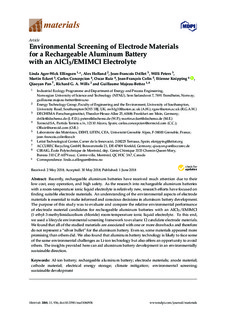| dc.contributor.author | Ellingsen, Linda Ager-Wick | |
| dc.contributor.author | Holland, Alex | |
| dc.contributor.author | Drillet, Jean-Francois | |
| dc.contributor.author | Peters, Willi | |
| dc.contributor.author | Eckert, Martin | |
| dc.contributor.author | Concepcion, Carlos | |
| dc.contributor.author | Ruiz, Oscar | |
| dc.contributor.author | Colin, Jean-François | |
| dc.contributor.author | Knipping, Etienne | |
| dc.contributor.author | Pan, Qiaoyan | |
| dc.contributor.author | Willis, Richard | |
| dc.contributor.author | Majeau-Bettez, Guillaume | |
| dc.date.accessioned | 2018-06-13T13:13:27Z | |
| dc.date.available | 2018-06-13T13:13:27Z | |
| dc.date.created | 2018-06-12T08:27:48Z | |
| dc.date.issued | 2018 | |
| dc.identifier.issn | 1996-1944 | |
| dc.identifier.uri | http://hdl.handle.net/11250/2501441 | |
| dc.description.abstract | Recently, rechargeable aluminum batteries have received much attention due to their low cost, easy operation, and high safety. As the research into rechargeable aluminum batteries with a room-temperature ionic liquid electrolyte is relatively new, research efforts have focused on finding suitable electrode materials. An understanding of the environmental aspects of electrode materials is essential to make informed and conscious decisions in aluminum battery development. The purpose of this study was to evaluate and compare the relative environmental performance of electrode material candidates for rechargeable aluminum batteries with an AlCl3/EMIMCl (1-ethyl-3-methylimidazolium chloride) room-temperature ionic liquid electrolyte. To this end, we used a lifecycle environmental screening framework to evaluate 12 candidate electrode materials. We found that all of the studied materials are associated with one or more drawbacks and therefore do not represent a “silver bullet” for the aluminum battery. Even so, some materials appeared more promising than others did. We also found that aluminum battery technology is likely to face some of the same environmental challenges as Li-ion technology but also offers an opportunity to avoid others. The insights provided here can aid aluminum battery development in an environmentally sustainable direction. | nb_NO |
| dc.language.iso | eng | nb_NO |
| dc.publisher | MDPI | nb_NO |
| dc.rights | Navngivelse 4.0 Internasjonal | * |
| dc.rights.uri | http://creativecommons.org/licenses/by/4.0/deed.no | * |
| dc.title | Environmental screening of electrode materials for a rechargeable aluminum battery with an AlCl3/EMIMCl electrolyte | nb_NO |
| dc.type | Journal article | nb_NO |
| dc.type | Peer reviewed | nb_NO |
| dc.description.version | publishedVersion | nb_NO |
| dc.source.volume | 11 | nb_NO |
| dc.source.journal | Materials | nb_NO |
| dc.source.issue | 6 | nb_NO |
| dc.identifier.doi | https://doi.org/10.3390/ma11060936 | |
| dc.identifier.cristin | 1590572 | |
| dc.description.localcode | © 2018 by the authors. Licensee MDPI, Basel, Switzerland. This article is an open access article distributed under the terms and conditions of the Creative Commons Attribution (CC BY) license (http://creativecommons.org/licenses/by/4.0/). | nb_NO |
| cristin.unitcode | 194,64,25,0 | |
| cristin.unitname | Institutt for energi- og prosessteknikk | |
| cristin.ispublished | true | |
| cristin.fulltext | original | |
| cristin.qualitycode | 1 | |

